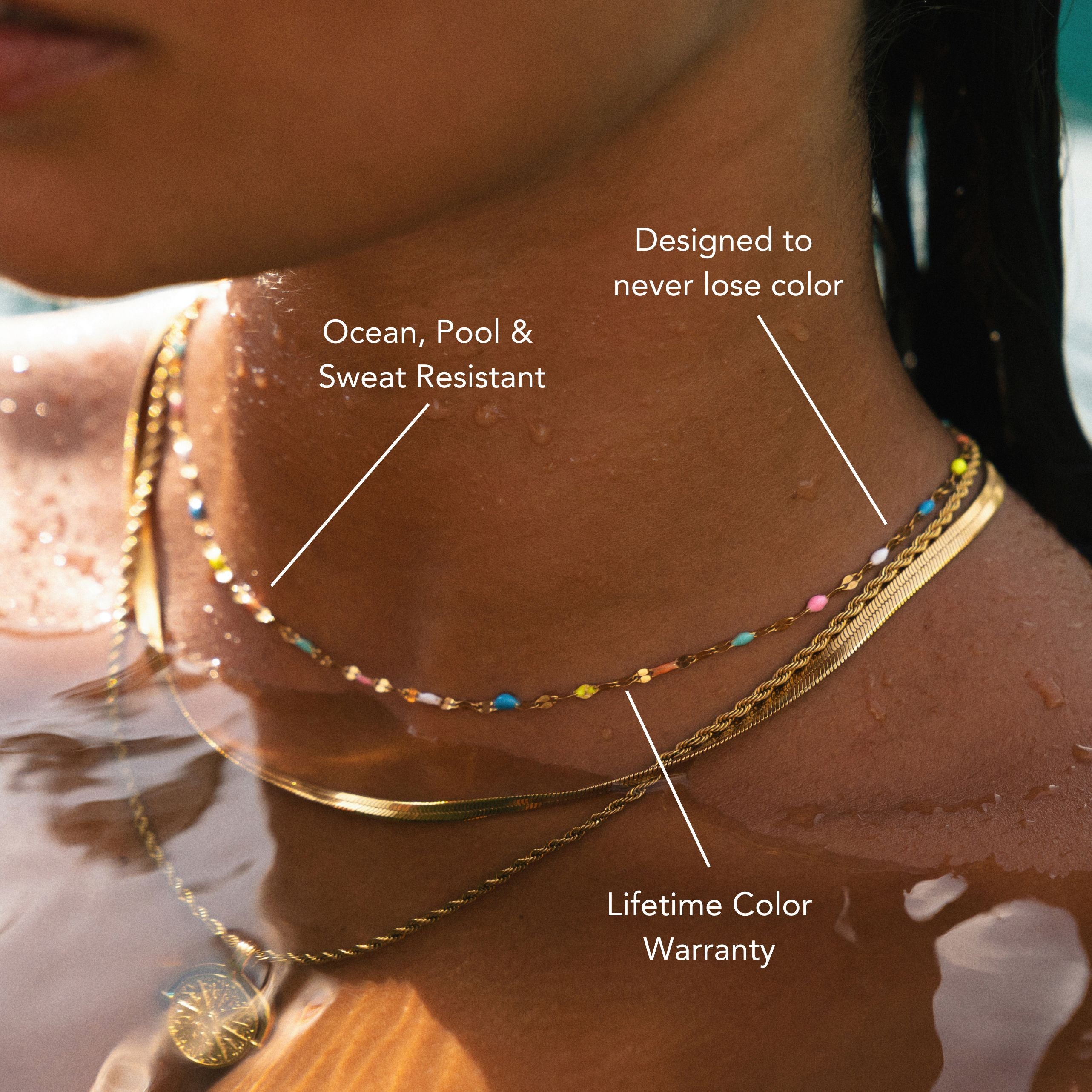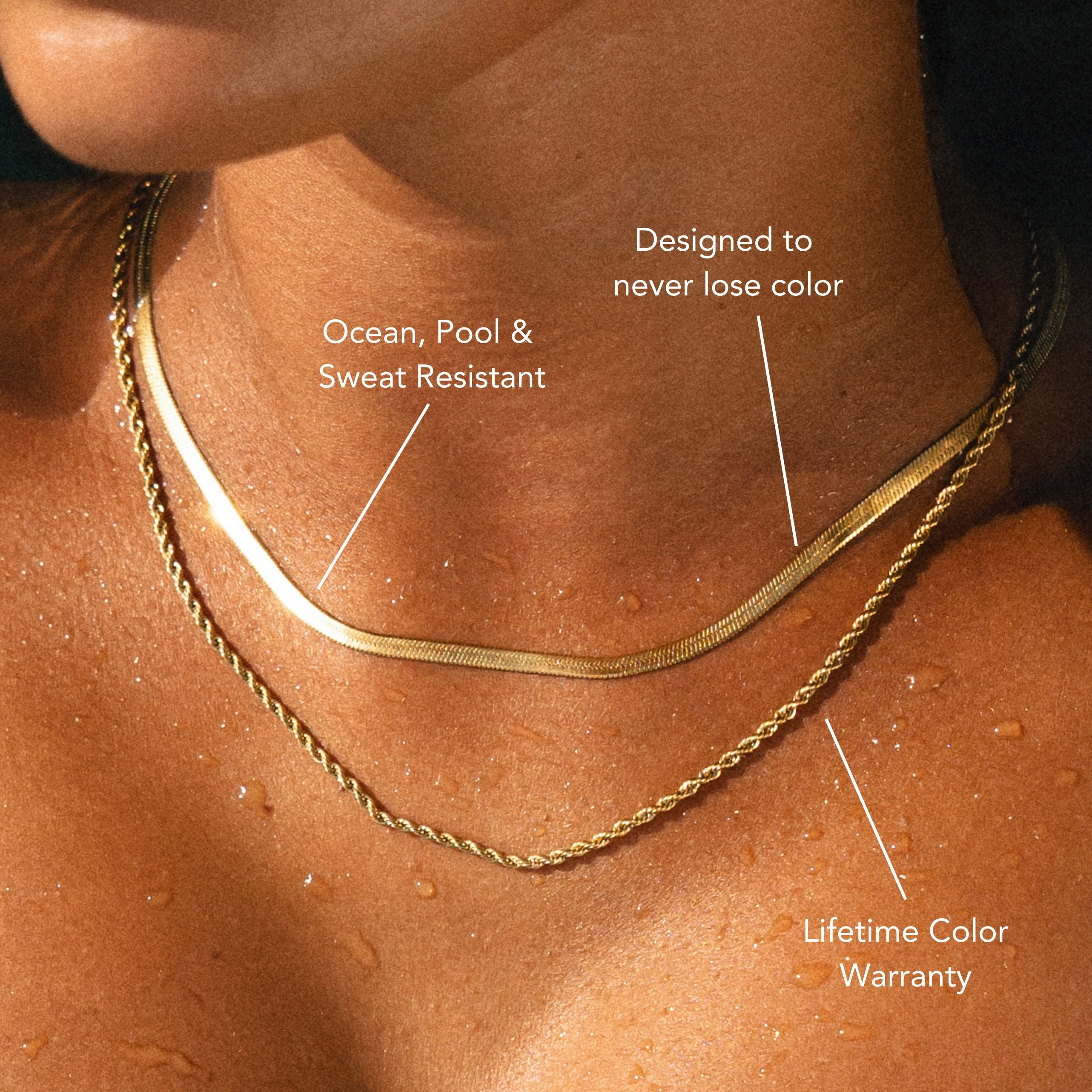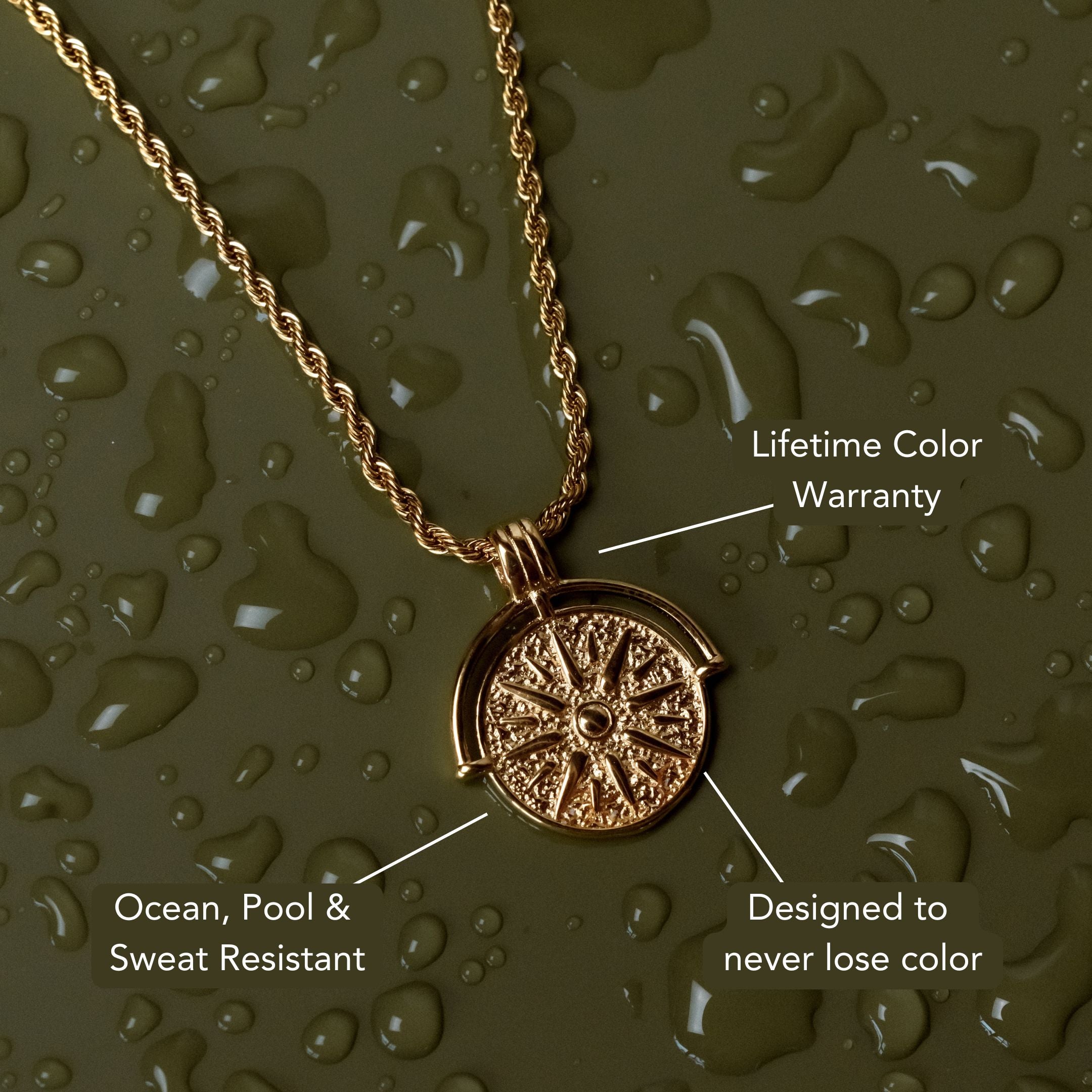
What Is a Lab Grown Diamond?
What is a lab grown diamond? A lab-grown diamond is a synthetic gemstone that mirrors the chemical composition and physical properties of natural diamonds, as both are primarily made of carbon atoms. Using advanced techniques like Chemical Vapor Deposition (CVD) and High Pressure High Temperature (HPHT), these diamonds are created in controlled environments, ensuring exceptional brilliance and durability. They offer a sustainable and ethical alternative to mined diamonds while being 20-40% more affordable, making them a great choice for budget-conscious buyers. For stylish and durable pairings, check out our Waterproof Jewelry collection.
Definition of Lab Grown Diamonds
Lab grown diamonds, often referred to as synthetic or cultured diamonds, are man-made gemstones that possess the same physical, chemical, and optical properties as their natural counterparts.
You'll find that these synthetic gems are created in controlled environments using advanced technological processes, primarily Chemical Vapor Deposition (CVD) and High Pressure High Temperature (HPHT) methods. Both techniques replicate the natural diamond formation conditions, resulting in gems that are virtually indistinguishable from mined diamonds.
Market trends indicate a significant shift towards the acceptance and popularity of lab grown diamonds. Factors contributing to this trend include growing consumer awareness about ethical sourcing and environmental concerns associated with traditional diamond mining.
As you explore the market, you'll notice that lab grown diamonds typically retail at a lower price point, making them an attractive alternative for budget-conscious consumers. The increasing availability of these diamonds has also led to a diversification in styles, cuts, and carat sizes, further appealing to a broader audience.
To summarize, understanding lab grown diamonds is essential for steering through today's evolving gemstone market, where synthetic gems are carving out a significant niche.
The Creation Process
To understand how lab grown diamonds are created, you need to explore two primary methods: High Pressure High Temperature (HPHT) and Chemical Vapor Deposition (CVD).
HPHT mimics the natural conditions under which diamonds form, applying intense pressure and heat to carbon sources.
In contrast, CVD uses a gas mixture that allows carbon atoms to deposit onto a substrate, gradually building up a diamond structure.
High Pressure High Temperature
High Pressure High Temperature (HPHT) is one of the primary methods used to create lab-grown diamonds, mimicking the natural processes that occur deep within the Earth's mantle.
In this process, you start by placing a carbon source, usually graphite, into a specially designed press. The press generates extremely high pressure, often exceeding 1.5 million pounds per square inch, and simultaneously applies intense heat, reaching temperatures around 2,500 degrees Celsius.
The combination of high pressure and heat treatment initiates a transformation within the carbon structure. Under these conditions, the carbon atoms rearrange themselves into a crystalline lattice, forming diamond. This transformation can take anywhere from a few days to several weeks, depending on the specific parameters used in the press.
Once the diamond crystallization is complete, the next step involves cooling the diamonds and removing them from the press. The resultant diamonds can then undergo further treatment to enhance their color and clarity.
HPHT diamonds aren't only chemically identical to natural diamonds but often possess unique characteristics that make them highly desirable in the gem market.
Chemical Vapor Deposition
Utilizing Chemical Vapor Deposition (CVD) represents a cutting-edge approach to creating lab-grown diamonds, where gaseous carbon compounds are transformed into solid diamond crystals.
In this process, you place a substrate in a vacuum chamber, introducing a carbon-rich gas, often methane. The chamber is then heated to high temperatures, typically around 800 to 1200 degrees Celsius, creating specific growth conditions for the diamond formation.
As the gas decomposes, it initiates a series of chemical reactions. These reactions cause carbon atoms to deposit onto the substrate, gradually forming diamond layers.
You can precisely control the growth rate and quality by adjusting parameters such as pressure, gas composition, and temperature, ensuring ideal conditions for diamond crystallization.
The CVD method allows for the production of diamonds with fewer impurities and defects compared to natural diamonds.
Additionally, it offers versatility in diamond size and type, catering to various industrial and gemological applications.
Ultimately, CVD represents a significant advancement in synthetic diamond technology, enabling the creation of high-quality diamonds with sustainable practices.
Key Characteristics
Lab grown diamonds exhibit a chemical composition that mirrors that of natural diamonds, ensuring identical physical properties such as hardness and brilliance.
This similarity underscores their appeal, as you get the same aesthetic and performance without the ethical dilemmas often associated with mined diamonds.
Additionally, the ethical sourcing practices involved in their creation provide a compelling reason for consumers who prioritize sustainability and responsible consumption.
Chemical Composition Similarity
Many people may not realize that lab-grown diamonds share nearly identical chemical compositions with their natural counterparts. Both types of diamonds consist mainly of carbon atoms arranged in a crystal lattice structure, exhibiting the same atomic structure. This similarity extends to their molecular properties, as lab-grown diamonds are synthesized under conditions that replicate the extreme temperature and pressure found in the Earth's mantle.
When you examine the atomic arrangement in both lab-grown and natural diamonds, you'll find that they both possess a tetrahedral lattice formation. This configuration contributes to the hardness and brilliance characteristic of diamonds. The molecular similarities between the two also mean that they interact with light in the same way, resulting in equivalent refractive indices and dispersion values.
Moreover, advanced technologies such as High Pressure High Temperature (HPHT) and Chemical Vapor Deposition (CVD) allow for precise control over the growth environment, ensuring that the resulting diamonds mirror their natural counterparts' physical and chemical properties.
Therefore, when you look at a lab-grown diamond, you're witnessing a gem that matches the essence of its natural sibling at a molecular level, debunking any preconceived notions about their authenticity.
Ethical Sourcing Practices
In recent years, the diamond industry has increasingly prioritized ethical sourcing practices, which play an essential role in distinguishing lab-grown diamonds from their mined counterparts. Lab-grown diamonds are produced in controlled environments, eliminating concerns associated with ethical mining practices that often plague the traditional diamond supply chain. By opting for lab-grown stones, you support a movement towards sustainability and transparency.
Ethical sourcing practices focus on minimizing environmental impact and ensuring fair labor conditions. Unlike mined diamonds, which may originate from conflict zones or involve exploitative labor, lab-grown diamonds are created using sustainable practices. These practices involve using renewable energy sources and reducing carbon footprints during production, which is critical in combating climate change.
Furthermore, lab-grown diamonds guarantee traceability, allowing you to know exactly where your diamond comes from, in stark contrast to the opaque routes of mined diamonds. This transparency not only assures you of the ethical integrity of your purchase but also encourages the diamond industry to adopt similar sustainable practices.
Benefits of Lab Grown Diamonds
The benefits of lab grown diamonds are becoming increasingly evident as consumers seek alternatives to mined gems. One of the most compelling advantages is their notably reduced environmental impact.
Traditional diamond mining can lead to extensive land degradation, habitat destruction, and water pollution. In contrast, lab grown diamonds require fewer natural resources and produce minimal waste, making them a more sustainable choice.
Cost effectiveness is another critical factor. Lab grown diamonds can be up to 40% cheaper than their mined counterparts, providing you with the opportunity to acquire a larger or higher-quality stone without breaking the bank.
This price difference is primarily due to the controlled production processes and the absence of the extensive logistics involved in mining.
Moreover, lab grown diamonds offer the same physical, chemical, and optical properties as natural diamonds, ensuring you won't compromise on quality.
You can enjoy the brilliance and beauty of a diamond while supporting sustainable practices. As you consider your options, it's clear that lab grown diamonds present a compelling blend of ethical sourcing, environmental responsibility, and economic advantage, making them a smart choice for the modern consumer.
Comparison With Natural Diamonds
When considering lab grown diamonds, it's important to understand how they stack up against natural diamonds. First, let's examine the cost comparison. Lab grown diamonds generally cost 20-40% less than their natural counterparts, primarily due to lower production costs and the absence of mining expenses. This price advantage makes them an appealing option for budget-conscious consumers.
Market trends also reveal a shifting landscape. As awareness grows about ethical sourcing and environmental concerns associated with mining, many consumers are opting for lab grown diamonds. This shift is further fueled by advancements in technology that enhance the quality and variety of lab grown options.
The resale value of lab grown diamonds is currently lower than that of natural diamonds, which can affect long-term investment considerations.
Moreover, the differences in composition and origin don't detract from the aesthetic appeal; both types are chemically identical. However, the narrative surrounding natural diamonds—often tied to heritage and rarity—remains strong, influencing consumer perceptions.
To summarize, while lab grown diamonds offer significant cost advantages and align with evolving market trends, their acceptance is still impacted by the established value associated with natural diamonds.
Popular Uses and Applications
How are lab grown diamonds transforming various industries beyond traditional jewelry? Their versatility is driving innovation across multiple sectors.
In jewelry, you'll notice that lab grown diamonds are at the forefront of emerging jewelry trends, appealing to ethically conscious consumers. Their affordability allows you to explore more intricate designs and larger stones without the hefty price tag associated with natural diamonds.
However, the applications don't stop there. In industrial contexts, lab grown diamonds serve vital roles due to their unmatched hardness and thermal conductivity. You'll find them used in cutting, grinding, and drilling tools, greatly enhancing performance and durability.
These diamonds also contribute to advancements in electronics, where their thermal properties improve heat dissipation in high-performance devices.
Moreover, in scientific research, lab grown diamonds are utilized in quantum computing and medical imaging, showcasing their potential beyond aesthetics.
As industries increasingly recognize the benefits of lab grown diamonds, you'll see their integration becoming more widespread. This evolution not only paves the way for innovative uses but also redefines how you perceive value and sustainability in both aesthetic and functional applications.
Frequently Asked Questions
Are Lab Grown Diamonds Ethically Sourced?
Yes, lab-grown diamonds are ethically sourced, as their production eliminates issues related to conflict minerals and environmental degradation. You can confidently choose them, knowing they align with sustainable practices and rigorous ethical standards in diamond production.
Do Lab Grown Diamonds Have Resale Value?
Lab grown diamonds generally have lower resale potential compared to natural diamonds. Market trends indicate that consumer demand fluctuates, impacting their value. You should research current prices and demand before investing in lab grown diamonds.
Can Lab Grown Diamonds Be Certified?
Yes, lab grown diamonds can be certified. They undergo a certification process adhering to industry grading standards, ensuring their quality and authenticity. This process evaluates cut, color, clarity, and carat weight, just like natural diamonds.
How Do Lab Grown Diamonds Affect the Environment?
Lab grown diamonds considerably reduce environmental impact by utilizing sustainable practices that lower the carbon footprint compared to traditional mining. You'll find they require less land disruption and water usage, promoting a more eco-friendly approach to diamond production.
Are Lab Grown Diamonds Cheaper Than Natural Diamonds?
When you conduct a price comparison, lab grown diamonds typically cost 20-40% less than natural diamonds. Analyzing market trends reveals increased consumer preference for lab grown options, further driving down their prices and enhancing accessibility.
Conclusion
In conclusion, lab-grown diamonds offer a sustainable and ethical alternative to natural diamonds, providing identical physical and chemical properties at a more accessible price point. Their creation process, utilizing advanced technology, results in gems that are indistinguishable from mined counterparts. By understanding the benefits and characteristics of lab-grown diamonds, you can make an informed decision when purchasing. As their popularity grows, these diamonds are redefining traditional perceptions of luxury and value in the gemstone market.

























Leave a comment
This site is protected by hCaptcha and the hCaptcha Privacy Policy and Terms of Service apply.